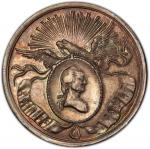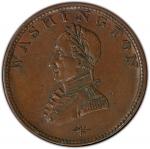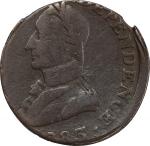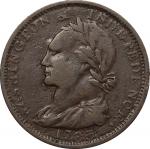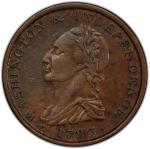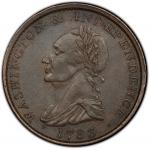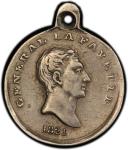1824 Lafayette Visit Medalet. Musante GW-112, Baker-198A. Silver. EF-40 (PCGS). 14.6 mm (without loop). 26.3 grains. With the original integral suspension loop not only intact, but with solid connectors that do not give an impression of fragility, though this certainly was the case for many of these medalets, as they are frequently seen with this feature lost. In fact, this is a perfectly pleasing example all around, with medium to light gray surfaces, the latter being on the higher points. A faint abrasion across Washingtons portrait has left a hairline scratch, but the eye appeal is little affected. Well-struck with good expression of the date and letters of both names. The rims are uneven and thin in places, as typical.<p><p><p>The vintage and purpose of these medalets are undisputed. They were struck to mark the occasion of the Marquis de Lafayettes return to the United States for an American tour in 1824. He arrived on August 15 and across the following 14 months, he visited each of the States of the Union where he was met with all manner of fanfare, from the casual donning of thematic gloves, badges, belts, combs, chains, socks, silks and anything else one might imagine, to more formal engagements such as visits to Mount Vernon (where he reportedly bumped his head at Washingtons tomb), a Congressional Banquet, a reception at the White House and dozens of other events. A <em>Grand Fete </em>at New Yorks Castle Garden was advertised for September 10. Though a French National, he was arguably the second greatest celebrity in the United States, with only George Washington ahead of him. <p><p><p>The matter of who made these medalets presents quite the opposite situation. For most of the last 198 years, these medalets have been attributed to Charles Cushing Wright, a resident of New York in 1824, and business partner (circa 1823-1827) of Asher B. Durand. Durand was a prominent copper and steel plate engraver and, later, painter of the Hudson River School. Wright was a highly skilled medallic engraver of his day. Both men were central figures in the establishment of the National Academy of Design a few years later. In 2008, John M. Kleeberg published a paper in the <em>American Journal of Numismatics, Second Series</em>, titled "Washington Counterstamps - The Lafayette Connection," proposing a different maker of this medalet, a New York engraver, Joseph Lewis. <p><p><p>Kleeberg began his proposal by arguing that Wright simply did not do the work based on the following evidence:<p><p><p>-A dissimilarity of letter punches used on these medalets versus those used on Wrights Erie Canal medal.<p><p><p>-The lack of a signature on these pieces, when Wright is known to have signed other works.<p><p><p>-The style of the Lafayette portrait which is much different than that seen on a Lafayette button produced by Scoville. At least one type was engraved by Wright and bears his signature at the portraits truncation. <p><p><p>None of this evidence solidly discounts Wright as the maker of these medalets, however, and there remains convincing circumstantial evidence that he may indeed have been the maker, not the least of which is the longstanding tradition of attributing them to his hand which goes back to at least 1864. In his sale of the John F. McCoy Collection in May of that year, W. Elliot Woodward attributed this medalet to C.C. Wright. Woodward, astute and active in the numismatic trade, would have presumably had some reason for such attribution. Though we do not know what that reason was, we do know that he put it in print just 8 years after Wrights death in 1857. Asher B. Durand lived until 1886, so it is quite possible that Woodwards knowledge was from a firsthand account. This detail was not addressed by Kleeberg, but it alone holds enough gravitas that it should not be discounted quickly.<p><p><p>As Kleeberg pointed out, there were three engravers advertising Lafayette medalets in New York at the time - Joseph Lewis, Robert Lovett, Sr., and James D. Stout. As an aside, the firm of Durand and Wright seems to have advertised nothing, though as will be illustrated, their shop was responsible for notable output at the time.<p><p><p>Kleeberg took the evidence of the three advertisers to mean that each engraver had produced his own medalet, assuming further that each "engraver" was also a medallic die-sinker. The evidence that seems to have directed Kleeberg to Lewis as the maker of this one is the fact that he placed a greater number of ads for <em>his </em>medal. In addition, a September 20 advertisement by Thomas Anners in the <em>Philadelphia Inquirer</em> announced his receipt of these medals for sale and included a note that "upwards of 2,000 of which were sold in ten days." Anners elsewhere labeled these "Lewiss," clarifying his source. This is the only tangible detail suggestive of Lewis as a maker, but it is not enough, as Lewis own advertising suggests otherwise. Kleeberg assumed that the larger number of ads placed by Lewis corresponded to greater sales, and that the <em>2,000 sold</em> announcement clarified Lewis as the maker of the Lafayette medalet best known today-this one.<p><p><p>This has been a troubling point for the present writer, as it is virtually inconceivable that a medalet so rare today would have had an original sales volume in the <em>thousands </em>of pieces. In addition, it is worth considering that it would have been a prized artifact, cared for and saved for at least a generation. Though physically small, the sentiments were grand, and this is not the sort of memento that would be quickly forgotten or discarded. Most likely, the original issue was vastly smaller than the Philadelphia advertisement indicated. On the other hand, these were very small and being sold in competition with many other diverse objects commemorating Lafayette. It is certainly possible that the original output was large but the medalets proved unpopular, sales were disappointing, and many were simply melted. A more nefarious option is that the comment of <em>2,000 sold</em> was little more than a salesmans embellishment.<p><p><p>The medalet Lewis offered was "adopted and ordered" by the Committee for the Grand Fete at Castle Gardens, scheduled for September 10, 1824, language taken directly from one of his advertisements, dated September 8. Numerous advertisements were placed offering these for sale. In fact, each of the three advertisers referenced by Kleeberg, Joseph Lewis, Robert Lovett and J.D. Stout included language in their New York <em>Evening Post</em> ads stating that what they were offering for sale were the medals intended for the Grand Fete at Castle Garden:<p><p><p>Lovett, September 8, 1824- "An Excellent likeness of Gen. La Fayette in gold and silver, intended to be worn at the Grand Ball on the 10th inst. for sale by the subscriber, the only good likeness yet executed in medallion."<p><p><p>Stout, September 9, 1824- "The Subscriber offers for sale…Miniature medals in medallion of this illustrious personage, whose name is in full round the heads, which are in gold on one side, and silver on the other…they have been made expressly for the Castle Garden Ball, which is to take place on the 10th instant…" Interestingly, Stout placed two advertisements in the September 9 edition, with the second one offering Lafayette gloves bearing an engraved portrait by C.C. Wright.<p><p><p>Lewis, September 8, 1824- "The subscriber offers for sale at his store…an exquisite miniature likeness of General La Fayette, warranted in fine gold and silver. The Committee for the Ball on the 10th inst., having adopted and ordered the above from the subscriber for their badge, they are recommended to be worn on that occasion-the best proof of the superiority of the likeness."<p><p><p>Another related offering appeared in Philadelphia newspapers with similar language:<p><p><p>Thomas Anners (the source for the <em>2,000 sold</em> mention), offered medals September 20, acquired from Lewis, describing them as "the same kind as was worn at the Grand Fete at Castle Garden in that city [New York]…" It is clear from this that whatever was struck in New York and intended for use at the Castle Garden event, did not sell out in New York. <p><p><p>The similar language by the three New York advertisers does not end with the Castle Garden reference. In none of them did the advertiser refer to himself as the <em>maker</em> of such a medalet. In the Lewis advertisement reproduced by Kleeberg, Lewis was offering for sale varied goods including "Rogers extra finished pen, pocket and sportsmens knives" (which he certainly did not make) and "ladies scissors, pencil cases, and visiting cards." It is highly unlikely that he was the maker of any but perhaps the visiting cards. The same advertisement closes with the following notice: "Visiting and Address Cards, Coats of Arms, Crests, &c. engraved and printed in a superior style, at the shortest notice, and on the most reasonable terms." Lewis was a plate engraver and printer, not a medallist. In the case of Stout, he also advertised as "now furnished with a great variety of this article [Lafayette Gloves]" for sale, "for the approaching Grand Ball." Interestingly, the gloves were decorated with an "excellent likeness" of Lafayette by the firm, Durand and Wright. Stouts other advertisements indicate that he, too, was a copperplate engraver as well as a general salesman of writing utensils, fancy goods, door plates and even a supplier of engravers copper plates, acquired from a London manufacturer. Robert Lovett, Sr. had just returned to New York in 1824, and placed few advertisements. In July, he advertised his jewelry store, offering an assortment of "embossed Bristol boards, cards, writing & note paper" as well as gold chains, seals, keys and "jewellery and silver ware of all kinds made to order." He referred to himself as a stone and metal seal engraver. Though he was likely capable of producing dies for such a medalet in 1824, it seems that his medallic work was more concentrated in the Hard Times era a decade later, during which he produced his own metallic card. <p><p><p>Durand and Wright appear in other advertisements relating to our case. James A. Campfield ran an advertisement in New Yorks <em>Evening Post</em>, September 25, 1824, offering Lafayette gloves, belts, badges, sashes, handkerchiefs, etc., bearing "the only good likeness" of Lafayette, "engraved by Durand" and "worn at the Grand Fete at Castle Garden." A later advertisement by him in the same paper, August 31, 1824, offered a "miniature likeness of General La Fayette, printed on white satin ribbon…(with additional ornaments) at 25 cents…and "Ladies Waist Ribbons tastefully ornamented with the above likeness…" Both were attributed to Asher B. Durand.<p><p><p>Admission tickets to the Grand Fete at Castle Garden were advertised in New Yorks <em>Evening Post,</em> September 8, 1824. Along with the general notice, cost and directions for application was the clear indication that the Committee of Arrangement for the Grand Fete had commissioned the printing of the official tickets. The advertisement noted that the "Tickets for the Fete will be ready for delivery on Wednesday morning" and it was made clear that orders for same should be made early so that the Committee could properly plan. This points to a contractual arrangement between the official organizers of the Castle Garden Grand Fete, and the engraving firm responsible for the tickets-Durand and Wright. An example may be seen at the New York Historical Society.<p><p><p>Though we have not uncovered concrete evidence that Charles Cushing Wright was indeed the maker of the Washington and Lafayette medalets, there is more than enough evidence to consider it highly likely, if in fact this is the medalet issued for the New York event. The other proposed candidates, though all advertising as engravers, never took credit for actually producing the medalets. In the cases of Lewis and Stout, they indirectly identified themselves as plate engravers and printers. They all advertised with similar language, identifying their medalets as those worn at the Grand Fete at Castle Gardens, indicating that they were probably all offering the same medal for sale, sourced from the maker. This would not have been an unusual distribution method at the time. They also sold other goods identified as having come from the Durand and Wright shop, and that firm also engraved and printed the official tickets for the event. The ties of Durand and Wright to the Grand Fete and their production of an array of retail goods celebrating Lafayette in New York indisputably tie them firmly to both the Castle Garden event and the broader retail sphere in general. Charles Cushing Wright was one of the most talented engravers of the day, working in New York. He thus seems a prime candidate as the maker of this medalet. <p><p><p>Undeniably, some questions do remain, largely sparked by the same body of contemporary advertising referenced above. The medalets are commonly offered in gold and silver, but where are the gold ones? William Spohn Baker reported one seen, and Fuld, Rulau and Musante appear to have trusted that entry. No citations of its whereabouts are given anywhere. J.D. Stout advertised the medalets as "gold on one side and silver on the other." What of this variation that must have been gilt on one side? Not one such Washington and Lafayette piece has come to the attention of the writer, nor was such a variant cataloged by Baker, Fuld, Rulau or Musante. <p><p><p>With these questions and another contemporary print advertisement, a heretofore unexplored possibility presents itself.<p><p><p>The advertisements referenced above all share language and point to the same article being sold, but they share another potentially significant detail-none of them mentions a Washington portrait. Since Lafayette was the celebrity of the day, and the key selling point, it is quite possible this was omitted in the interest of streamlining the ads. However, it is also possible that the medal being offered did not have a Washington portrait on the other side. <p><p><p>We are aware of one medal that fits the descriptions in these advertisements. It is an oval Lafayette medalet, with his portrait on both sides. We have sold perhaps four of these over the last 15 years and one, appearing in our August 2013 Ford Sale at lot 21250, was indeed gilt on one side, unmistakably matching the language in the September 9th Stout advertisement. If this should be the medal offered in the body of advertising presented above, then it had a remarkably high attrition rate, as it is a great rarity. <p><p><p>Ash & Mason of Philadelphia announced on September 24th, that they had just received for sale, "La Fayette Medals, of Gold and Silver / Having on them impressions of Washington and La Fayette, such as have been recommended to be worn at the approaching Grand Ball." This entry post-dates the Castle Garden event, but it is interesting that they had "just received" what is clearly a medalet of this specific style for retail sale, and it is the only notice we have seen that specifies Washington and Lafayette portraits on opposing sides. The question is, where was it received from? We know that the medalet offered by Lewis, Stout and Lovett did not sell out in New York, as the same was offered by Anners in Philadelphia. So, this could have been the same New York medalet repurposed for the Philadelphia event, on September 28, or it could have been something else altogether.<p><p><p>The possibility that Ash & Mason were offering an entirely different medalet for the Philadelphia market is an intriguing one. If it were this one, it would naturally all but certainly remove C.C. Wright as the potential author, and open further inquiry as to who made it.<p><p><p>One possibility of authorship in this scenario who does not seem to have been explored is Christian Gobrecht. Gobrecht was active in Philadelphia at the time, and clearly a skilled die-sinker by that date. He is known to have produced excellent medallic works of the era, including the 1824 Franklin Institute award medal, Peales Museum medals, the 1826 Charles Carroll of Carrollton medal and the 1826 New England society for Promotion of Manufactures and Mechanical Arts medal. The latter two issues have some tiny lettering in their designs, and though it is an imperfect science, many of the letter forms are very similar to those seen on the medalet offered here. It is worth mentioning also that many of the coins counterstamped by these dies seem to have been high-grade issues dated 1822-1824, the kinds of coins that would presumably have been more readily found in Philadelphia in 1824 than anywhere else. <p><p><p>Unfortunately, further questions remain unanswered relating to these issues. In a September 13 advertisement placed by Lewis offering Lafayette medals, he requests: "Purchasers will please to mention whether for ladies or gentlemen, as a number has been prepared expressly for the ladies and the military distinct." How are these variations different? And, significantly, who made the other extremely rare medalets that match the general description of these, but are clearly by different hands? One type is a Washington and Lafayette medalet similar to this, but of cruder style. Just two are known, and one can be seen in our November 2020 sale, lot 4340. Additionally, two more Lafayette dies of this size have been observed, one dated 1824 and counterstamped on an 1818 quarter, the other undated and countermarked on an 1817 large cent. Each is unique, as far as we are aware.<p><p><p>The Grand Fete at Castle Garden was a huge event with reportedly more than 6,000 people in attendance. The medalets associated with it were adopted and ordered by the committee, and they were somewhat widely advertised. These facts still suggest that the most commonly seen medalet fitting the general description would be the one likely issued for that event. It is difficult to ignore this detail, and we circle back to the 1864 publication by Woodward that Wright made these medals as something that cannot yet be dismissed. Joseph Lewis, however, is clearly out of the running as an option, and the same is likely true of Stout and Lovett.<p><p><div>Despite the lingering questions, these medalets have long been prized for their unique historic significance marking Lafayettes American tour. If this is, in fact, the type issued in New York, large numbers are suggested to have been issued by the contemporary print advertising, but most have clearly been lost. Whatever the case, the fact remains that these medalets are quite rare today and only about half retain a suspension loop. Our online archives include about ten different examples sold over the last 15 years or so, while Heritage seems to have sold only a couple. Even the ANS Collection seems to be missing the type. From the Sydney F. Martin Collection. Purchased privately at the Tri-County Coin Club, November 2004, source unrecorded.









